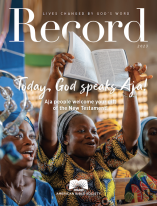How to Use Technology to Help Millennials Read the Bible
Start a small group based on texting.
I have a love-hate relationship with technology. Purchasing my iPhone several years ago simplified and enlarged my life. With a GPS in my hand, I could go anywhere. I could know what was going on in the world at any given moment, just one app away! I could calculate tips, budget, check the weather—the list was endless.
But I soon found myself defaulting to my phone rather than intentionally investing in relationships. Instead of calling a family member, I looked at their Instagram. Instead of being present with a friend during a difficult time, I texted an emoji.
Yet technology offers us a valuable opportunity to connect with people at any time or place. Given the right focus, technology can be a tool that brings us together and enriches our thinking.
The 2015 “State of the Bible” report shows that 33% of Millennials admit to never reading the Bible, and yet this generation leads the way in using digital Bible formats.
How can churches use technology to come alongside Millennials? Can we take platforms they are already choosing and employ them to deepen Scripture reading practices and foster more intentional connections with one another?
For instance, many Millennials find that texting is an easy mode of communication. It’s one of the fastest ways to share information, stay connected, and remain up-to-date in our fast-paced culture. So why not invite Millennials in your church to join a “virtual” small group, allowing people to engage with Scripture through texting? Here is one idea that may be helpful. (Feel free to tweak it for your specific ministry context.)
How-To
- Gather groups of four—people who want to connect with Scripture and one another.
- Agree on a Bible passage to study and create a schedule of chapters or verses to read each week. A shorter book, like Philippians, will let you get started with a four-week trial run (one chapter per week). If the participants like the experience, they can try it again, perhaps with a longer book and a more extended period of time.
- Have each member of the group choose a different day of the week to initiate the discussion. On their day, each week, they text the others a particular verse or section to focus on, along with a thought or question about it. Then the other members of the group text back their thoughts, questions, and reflections.
- This could be done in conjunction with a weekly get-together in person, but it doesn’t have to be. What’s most important is the discussion and personal reflection sparked by texting throughout the week.
A Hopeful Future
Using a familiar platform, this low-commitment but high-structure model allows people to do their own Bible study, teaching one another. The schedule (four times a week) establishes regular Bible engagement, but it’s also organic, allowing each group to dig as deep as they want.
Mobile technologies continue to shape our culture and become more entwined with our daily lives, but they don’t need to distract or divide us. They can help facilitate connection and spiritual formation. As leaders in the church, we can help people use these tools for their benefit, finding real life together and modeling a hopeful future for our communities.
Written in collaboration with Randy Petersen.
Thanks to the support of our faithful financial partners, American Bible Society has been engaging people with the life-changing message of God’s Word for more than 200 years.
Help us share God's Word where needed most.
Connect with our Bible engagement blog for leaders and receive a Bible-reading Habit Guide for your community.









